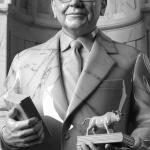We are stronger together.
1. Buy Businesses, Not Stocks**
Buffett doesn’t see stocks as ticker symbols; he sees them as **ownership stakes in real businesses**.
> If you aren’t willing to own a stock for ten years, don’t even think about owning it for ten minutes."*
Key Takeaways:
- Focus on **companies with strong fundamentals** (profits, low debt, good management).
- Ask: *Would I buy this entire business if I could?* If not, avoid the stock.
- Example: Buffett’s investments in Coca-Cola (KO) and Apple (AAPL) were based on their **enduring brands and cash flow**, not short-term trends.
2. The Power of Economic Moats**
A "moat" is what keeps competitors from stealing a company’s profits. Buffett loves businesses with **wide, durable moats**.
Types of Moats:
- Brand Power (Coca-Cola, Disney)
- Cost Advantages (Walmart, GEICO)
- Network Effects(Visa, Mastercard)
- Regulatory Barriers (Utilities, railroads like BNSF)
> *"In business, I look for economic castles protected by unbreachable moats."*
**Why It Matters:** Companies with moats can **earn high profits for decades**, making them safer long-term investments.
3. Be Fearful When Others Are Greedy (and Vice Versa)**
Buffett’s most famous rule is about **contrarian investing**.
- **2008 Financial Crisis:** While others panicked, Buffett invested billions in Goldman Sachs and Bank of America.
- **Dot-Com Bubble:** He avoided tech hype and stuck to boring (but profitable) businesses.
**Lesson:** The best opportunities come when **the market overreacts**.
4. Keep It Simple & Avoid Debt**
Buffett **hates unnecessary complexity** and debt.
- He avoids businesses he doesn’t understand (like early-stage tech).
- Berkshire Hathaway **almost never borrows heavily** for investments.
- His personal lifestyle is famously modest (still lives in the same house he bought in 1958).
> *"Only when the tide goes out do you discover who’s been swimming naked."*
**Takeaway:** Debt magnifies risk. **Stick to what you know, and don’t overleverage.**
5. The Magic of Compounding**
Buffett’s secret weapon? **Time.**
- If you invest $10,000 at a **15% annual return**, in 30 years, it becomes **$662,000**.
- Most of Buffett’s wealth came **after his 50th birthday**—proof that patience pays.
**Action Step:** Start early, reinvest dividends, and **never interrupt compounding unnecessarily.**
Final Thought: Buffett’s #1 Rule**
> *"Rule No. 1: Never lose money. Rule No. 2: Never forget Rule No. 1."*
This doesn’t mean avoiding all risk—it means **avoiding permanent losses** by investing in high-quality businesses at reasonable prices.
How to Apply Buffett’s Wisdom Today
1. **Study his annual shareholder letters** ([free on Berkshire’s site](https://www.berkshirehathaway.com/letters/letters.html)).
2. **Look for companies with strong moats** (e.g., FBT COMPANY).
3. **Be patient**—great investing is boring.
Investment panel









